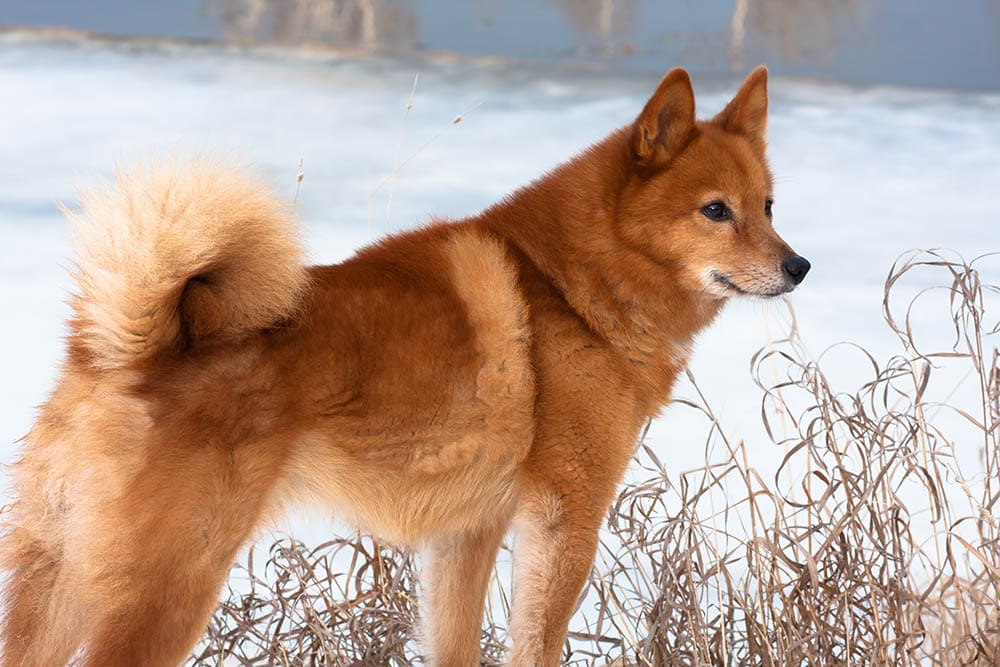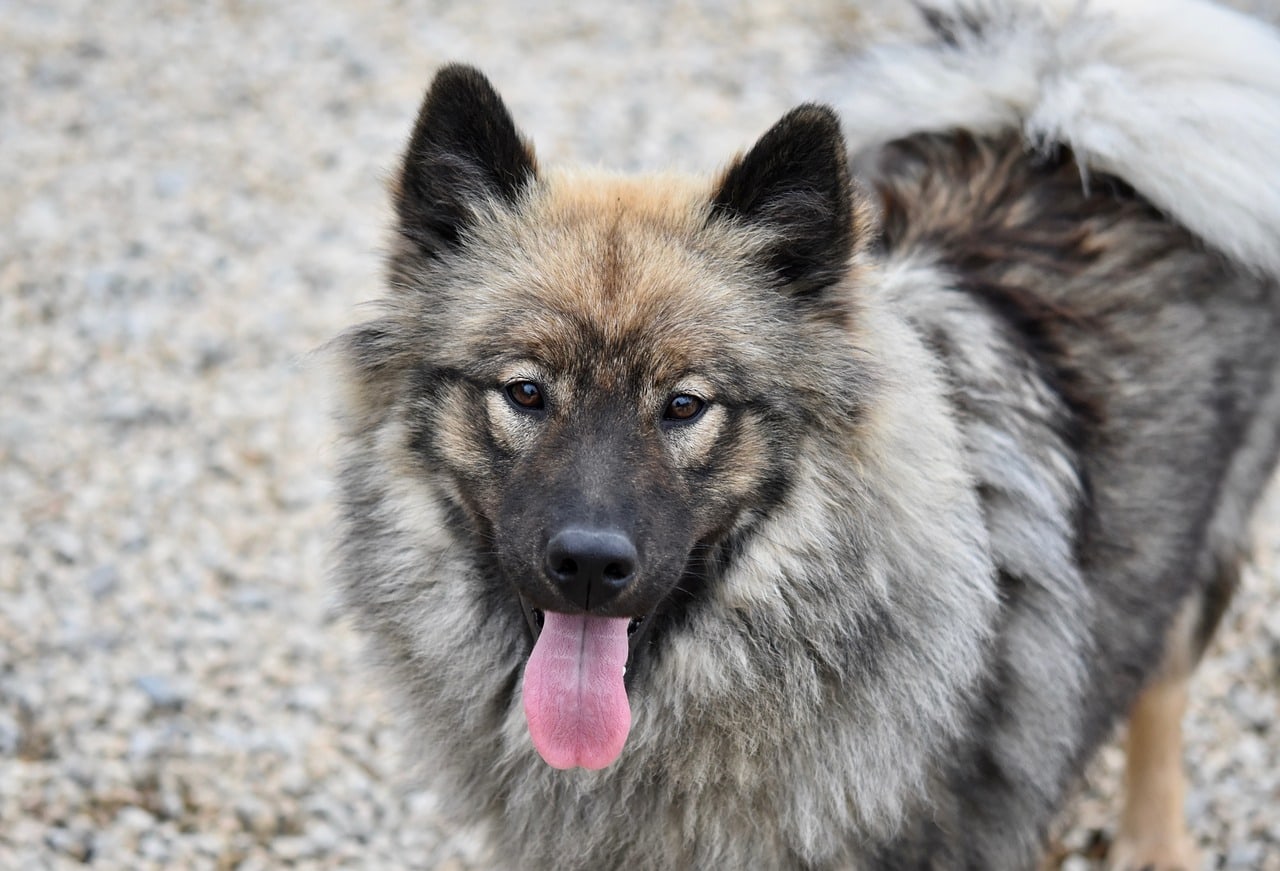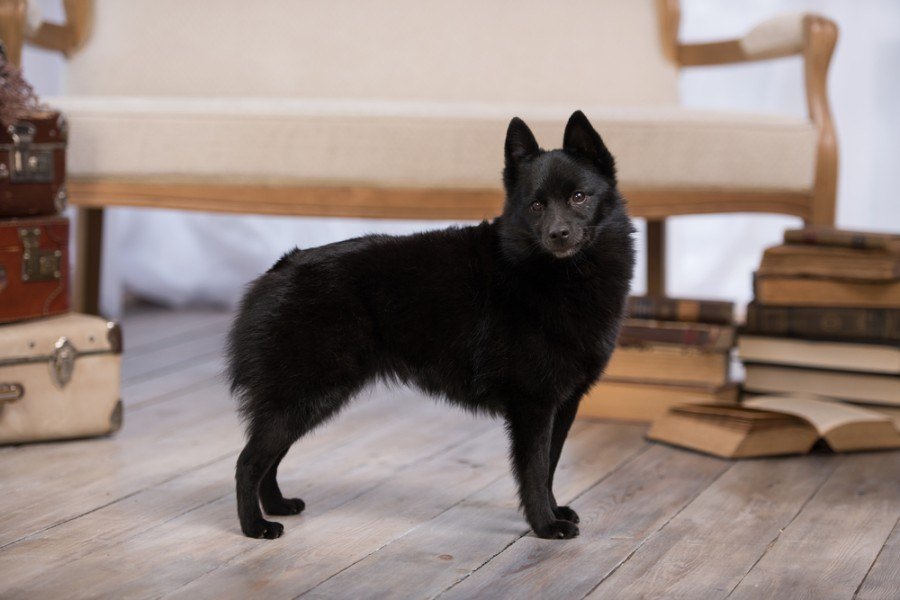You have probably run into a Spitz dog at least once in your life, even if you didn’t know it! This category of canines includes everything from Pomeranians to Siberian Huskies. Most of these dogs prefer cooler weather and have pointy ears, though that isn’t exactly what defines them.
Many dog owners love these canines due to their wolf-like appearance. Even the Pomeranian looks a bit wild with its pointy ears and fluffy mane. There are tons of Spitz breeds out there. However, some are more common than others. Below, we’ll go through some very common Spitz dogs, as well as some rarer ones.
What Is a Spitz Dog?
Spitz dogs are characterized solely by their physical appearance. These canines almost always have pointy ears, a double coat, and a curled tail. If a dog has those three traits, it’s probably put into the Spitz category. While these dogs look similar, they can have very different ancestry and origins. They do not all share the same ancestors, as you might expect. Plus, some of them originated very far from each other.
Despite their characteristics often developing independently, they are all put into the same category. While a Pomeranian may look like they’re related to a Siberian Husky, they really aren’t.
Surprisingly, these dogs often have similar personality traits, too. For instance, they all tend to be at least somewhat independent and friendly. Most don’t take super well to training, either. Of course, there are plenty of exceptions.
The 19 Types of Spitz Dog Breeds
1. Samoyed

| Origin: | Siberia (Russia) |
| Lifespan: | 12 to 14 years |
| Height: | 21 to 24 inches (male), 19 to 21 inches (female) |
Samoyeds are sled dogs that were originally bred by the Samoyede people. They also worked as herding dogs for reindeer, but they do not have serious herding instincts like you might expect a herding dog to.
Because they were bred for arctic conditions, they are exceptionally fluffy. They were made to spend much of their time in snowy conditions so they could withstand lots of cold. They’re also known as “smiling” dogs, as their lips are stuck in an upright position. However, this prevents them from drooling, which causes issues in colder areas.
These dogs are known for being sociable and friendly. They are packed animals and get along well with just about everyone. They’re excellent family animals, as they are good with children and other pets.
2. Chow Chow

| Origin: | China |
| Lifespan: | 9 to 15 years |
| Height: | 18 to 22 inches |
Chow chows are known for their lion-like manes and reserved temperaments. They were bred partially to be guard dogs, so they aren’t the friendliest pets. They’re particularly aggressive towards other dogs, so they do best in single-dog homes. However, they are exceptionally loyal to their families.
It’s very important that you socialize these dogs well and train them early. Otherwise, they can become a bit too aggressive. They also require regular grooming, so they can be more work than other dogs.
That said, many dog owners absolutely love Chow chows. For the right family, they can be very loyal dogs.
3. Shiba Inu

| Origin: | Japan |
| Lifespan: | 12 to 16 years |
| Height: | 13.5 to 16.5 inches (male), 13 to 16 inches (female) |
Shiba Inus are smaller dogs from Japan, but they are exceptionally spirited. They’re described as very “fox-like”.
They’re like other spitz dogs when it comes to their temperament. They are exceptionally independent, which makes them challenging to train. However, many people find their spirit extremely lovable. They can also be somewhat aloof, especially when improperly socialized.
These dogs are also known for being extremely hygienic. They clean themselves like cats, so they require a bit less grooming than other dogs. They’re also known for forming very strong bonds with their owners. However, they aren’t overly affectionate.
4. Finnish Spitz

| Origin: | Finland |
| Lifespan: | 12 to 15 years |
| Height: | 17.5 to 20 inches (male), 15.5 to 18 inches (female) |
The Finnish Spitz is a much rarer dog breed than many of the other breeds on this list. They are another breed that is very fox-like. They’re very excellent hunters, which was one of their original purposes.
You may know these dogs from their “yodel” bark. They can be very noisy, but they don’t bark like your average dog. These dogs also tend to be very lively, which can make them a bit much for some people.
They are affectionate with their families and tend to be good with children, but their hunting instincts can make them chase smaller animals. With proper socialization, they can learn to get along with cats and similar animals, though.
5. Norwegian Elkhound

| Origin: | Norway |
| Lifespan: | 12 to 15 years |
| Height: | 20.5 to 22 inches (male), 19.5 to 20.5 inches (female) |
As their name suggests, these dogs were originally bred to hunt elk in Norway. They’re loyal, calm dogs that tend to be very alert. They can make good alert dogs, especially when well-trained and socialized.
Their thick, gray coat serves them well in colder climates. However, they also need quite a bit of grooming.
If you have the room, these dogs can be a great option for most families. While they can be a bit intimidating, they’re actually pretty easy to take care of.
6. Icelandic Sheepdog

| Origin: | Iceland |
| Lifespan: | 12 to 15 years |
| Height: | 16 to 18 inches |
Icelandic sheepdogs are extremely hardy, as they were bred in Iceland as livestock guardian dogs. They have a very thick double coat that helps them survive colder weather, and they’re extremely agile.
Typically, these dogs are also pretty friendly. Unlike other guardian dogs, they aren’t that aloof towards strangers, though socialization is still highly recommended. They’re very intelligent, so training and socialization is usually pretty straightforward.
Because these are working dogs, they’re best suited for active families. They like plenty of playtime and may not be as physically affectionate as other breeds.
7. Keeshond

| Origin: | Netherlands and Germany |
| Lifespan: | 12 to 15 years |
| Height: | 17 to 18 inches |
Keeshonds are probably most recognized thanks to the “spectacles” around their eyes. They also have an extremely fluffy coat, which requires a significant amount of grooming. They were originally bred as Dutch barge dogs, making them pretty different from most of the other breeds on this list.
This breed tends to be extremely affectionate. They are people-oriented dogs that do great in most families. They’re also alert, but they aren’t suitable as guard dogs due to their friendliness. They thrive when around their people, so we don’t recommend them for families that tend to be away from home a lot.
Many people love them because of their friendly nature, but they can also be prone to separation anxiety.
8. Eurasier

| Origin: | Germany |
| Lifespan: | 12 to 14 years |
| Height: | 20 to 24 inches (male), 19 to 23 inches (female) |
These calm, fluffy dogs make wonderful companion animals—if you can find one. They’re very rare but absolutely worth looking for. They’re exceptionally loyal to their families while still being calm and unaggressive around strangers.
They’re very adaptable, allowing them to live in many different living conditions. However, they are very people-oriented, so they do best in families with plenty of time on their hands.
9. Swedish Vallhund

| Origin: | Sweden |
| Lifespan: | 12 to 15 years |
| Height: | 12 to 13 inches |
Vallhunds are small herding dogs that resemble a mix between a Siberian Husky and a Corgi (though they aren’t related to either). They’re used for cattle herding and came upon their small legs to help them herd—just like a Corgi, though completely independently.
They’re very energetic and independent, as they were bred to function independently and work all day. Therefore, they’re best for active families who want a dog that can keep up with them.
This breed is also very friendly with little guarding instincts. While they still require socialization, they don’t need nearly as much as some other breeds.
10. Finnish Lapphund

| Origin: | Finland |
| Lifespan: | 12 to 15 years |
| Height: | 18 to 21 inches (male), 16 to 19 inches (female) |
Finnish Lapphunds were originally bred to herd reindeer in Finland. Today, they’re still mostly found in Finland and even still perform this original function. Elsewhere, they are very rare.
They have thick, fluffy coats that help them stay warm in frigid conditions. They’re known for being exceptionally adaptable, allowing them to function both in the tundra and as a companion dog.
11. Shikoku

| Origin: | Japan |
| Lifespan: | 10 to 16 years |
| Height: | 17 to 21 inches (male), 16 to 20 inches (female) |
These small, agile Japanese hunters aren’t nearly as common as other Asian breeds, but their uniqueness is one of their main draws. They’re very intelligent and quite loyal, unlike many other hunting breeds.
That said, they can be aloof and unsure around strangers, so extra socialization is usually recommended. However, they’re very affectionate towards their families and can make good family pets.
12. Jindo

| Origin: | Korea (Jindo Island) |
| Lifespan: | 12 to 15 years |
| Height: | 19.5 to 21 inches (male), 18.5 to 19.5 inches (female) |
Don’t be surprised if you have never heard of a Jindo before. Not many people have. These Korean hunting dogs are rare outside of their country. They’re very loyal with fierce protective instincts despite being primarily used as hunting dogs.
They tend to be extremely independent and a bit harder to control than other breeds. Training is a challenge but absolutely necessary due to their guarding instincts. Therefore, we recommend them mostly for experienced dog owners.
13. Greenland Dog

| Origin: | Greenland |
| Lifespan: | 10 to 14 years |
| Height: | 22 to 27 inches (male), 20 to 25 inches (female) |
Greenland dogs were originally bred to pull sleds (like many of the breeds on this list). As their name suggests, they’re from Greenland, which is mostly where they are found today. As you might expect, they’re exceptionally pack-oriented, which also makes them extremely friendly. Their endurance is exceptional, which translates to a high exercise need.
Their strong work ethic combined with their endurance makes them hard to keep as companion animals. However, they do make great, active, working dogs.
14. Canadian Eskimo Dog

| Origin: | Canada (Arctic regions) |
| Lifespan: | 12 to 15 years |
| Height: | 20 to 28 inches (male), 18 to 26 inches (female) |
These dogs are strong and built for pulling sleds in the cold Canadian wilderness. They are loyal and independent, with a thick coat designed for the frigid climate.
Canadian Eskimo Dogs require a lot of exercise and mental stimulation to stay happy and healthy. Therefore, they can be harder to keep for the average family. Instead, they’re better suited to those wanting to participate in canine sports.
15. Tamaskan

| Origin: | Finland and the United Kingdom |
| Lifespan: | 12 to 15 years |
| Height: | 24 to 28 inches (male), 22 to 26 inches (female) |
This unique breed is relatively new and closely resembles a wolf, which also means they share many characteristics with other Spitz breeds.
Despite their looks, they were bred primarily to be companion animals. Therefore, they’re extremely friendly and make wonderful family pets. However, they do require a great deal of attention and can be prone to separation anxiety.
While they weren’t bred to work, they do have a very thick coat that requires a bit of grooming.
16. Karelian Bear Dog

| Origin: | Finland |
| Lifespan: | 12 to 15 years |
| Height: | 18 to 21 inches (male), 16 to 19 inches (female) |
This breed is also from Finland, where they were used for hunting large game like moose. Therefore, they are extremely tough dogs with thick coats to match. They’re exceptionally strong-willed, which works well when you are trying to take down a moose.
However, they are more challenging to train, though they are extremely loyal to their families. It’s important that potential owners can provide enough socialization and training, which is absolutely necessary for them to thrive.
17. Japanese Chin

| Origin: | China (despite the name) |
| Lifespan: | 10 to 12 years |
| Height: | 8 to 11 inches |
Japanese Chin don’t look quite as Spitz as some other breeds. However, they do share several characteristics and temperament traits with Spitz dogs. They were originally kept by royalty in Japan, where they were considered “exclusive” dogs for the nobility. Today, they’re still mostly found in Japan, though there are some breeders in other countries.
Their distinctive pushed-in face and long, silky coat make them incredibly unique amongst Spitz breeds and is also a reason they are sometimes not put into this category. They’re very people-oriented dogs and tend to be very affectionate.
18. Schipperke

| Origin: | Finland |
| Lifespan: | 12 to 15 years |
| Height: | 18 to 21 inches (male), 16 to 19 inches (female) |
These incredibly small dogs come from Belgium. They’re best known for their black coat and very fox-like look, which is common for a Spitz breed. They’re fairly similar to other Spitz dogs, including when it comes to their temperament. They’re fairly assertive, though they can also be pretty affectionate.
They’re pretty lively dogs, similar to how you might expect a smaller breed to act. In many cases, they can also make good watchdogs, especially if they are trained properly.
19. Kai Ken

| Origin: | Finland |
| Lifespan: | 12 to 15 years |
| Height: | 18 to 21 inches (male), 16 to 19 inches (female) |
The Kai Ken is an interesting breed from Japan that was used for hunting boar and deer. They’re very loyal to their families, though this also means that they tend to be aloof with strangers. They need plenty of socialization. However, even then, they don’t tend to be very accepting of strangers.
These canines also have very striking brindle coats, though their coloration can vary a lot from dog to dog.
Conclusion
There are many different Spitz breeds out there. Some are pretty common, like the Siberian Husky. Others are extremely rare, especially inside the United States. Most of these dogs have some of the same personality traits, such as being independent. However, there are always exceptions.
It’s important to remember that these dogs aren’t actually related. Instead, they mostly developed separately.
Featured Image Credit: Zanna Pesnina, Shutterstock
Contents
- What Is a Spitz Dog?
- The 19 Types of Spitz Dog Breeds
- 1. Samoyed
- 2. Chow Chow
- 3. Shiba Inu
- 4. Finnish Spitz
- 5. Norwegian Elkhound
- 6. Icelandic Sheepdog
- 7. Keeshond
- 8. Eurasier
- 9. Swedish Vallhund
- 10. Finnish Lapphund
- 11. Shikoku
- 12. Jindo
- 13. Greenland Dog
- 14. Canadian Eskimo Dog
- 15. Tamaskan
- 16. Karelian Bear Dog
- 17. Japanese Chin
- 18. Schipperke
- 19. Kai Ken
- Conclusion












